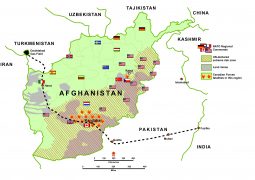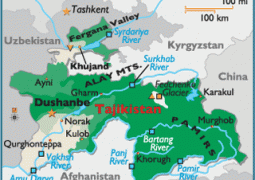Afghanistan War Cost, Timeline and Economic Impact

The Ongoing Costs of the Afghanistan War
The Afghanistan War is a military conflict that began in 2001 and has cost $1.07 trillion. The Bush administration launched it in response to the 9/11 terrorist attacks by al-Qaida. The United States attacked the Taliban in Afghanistan for hiding al-Qaida’s leader, Osama bin Laden. It was the kick-off to the War on Terror.
The war’s $1.07 trillion cost has three main components. First is the $773 billion in Overseas Contingency Operations funds specifically dedicated to the Afghanistan War.
Second is the increase of $243 billion to the base budget of the Department of Defense. Third is the increase of $54.2 billion to the Department of Veteran Affairs budget.
Some of these costs are also attributable to the War in Iraq. But the true cost of the Afghanistan War should include the addition to these departments, even if some of the funds went toward both wars.
The U.S. military budget is the second highest federal budget expense after Social Security.
Timeline of Afghanistan War Costs
Here’s a timeline of what happened each year. A table that summarizes these costsis below.
Fiscal Year 2001 – $37.3 billion: Osama bin Laden authorized 9/11 attacks. President Bush demanded that the Taliban deliver bin Laden or risk U.S. attack. Congress appropriated $22.9 billion in emergency funding. On October 7, U.S. jets bombed Taliban forces. On December 7, the Taliban abandoned Kabul, the capital.
Hamid Karzai became interim administration head. That same month, ground troops pursued bin Laden into the Afghan foothills. He escaped to Pakistan on December 16, 2001.
FY 2002 – $65.1 billion: In March, the U.S. military launched Operation Anaconda against Taliban fighters. Bush promised to reconstruct Afghanistan, but only provided $38 billion between 2001 and 2009.
Bush turned attention to Iraq War.
FY 2003 – $56.7 billion: In May, the Bush Administration announced that major combat ended in Afghanistan. The North Atlantic Treaty Organization took over control of the peacekeeping mission. NATO added 65,000 troops from 42 countries.
FY 2004 – $29.6 billion: On January 9, Afghanistan created a new Constitution. On October 9, the U.S. military protected Afghans from Taliban attacks for their first free election. On October 29, bin Laden threatened another terrorist attack.
FY 2005 – $47.4 billion: On May 23, Bush and Karzai signed an agreement allowing U.S. military access to Afghan military facilities in return for training and equipment. Six million Afghans voted for national and local councils. Three million voters were women.
FY 2006 – $29.9 billion: The new Afghanistan government struggled to provide basic services, including police protection. Violence increases. The United States criticized NATO for not providing more soldiers.
FY 2007 – $57.3 billion: Allies assassinated a Taliban commander, Mullah Dadullah.
FY 2008 – $87.7 billion: Violence escalated in Afghanistan after U.S. troops accidentally killed civilians.
FY 2009 – $100 billion: President Obama took office.
He sent 17,000 more troops to Afghanistan in April. He promised to send another 30,000 in December. He named Lt. General McChrystal as the new commander. Obama’s strategy focused on attacking resurgent Taliban and al-Qaida forces on the Pakistan border. That added $59.5 billion to Bush’s FY 2009 budget. He promised to withdraw all troops by 2011. Voters reelected Karzai amidst accusations of fraud.
FY 2010 – $112.7 billion: NATO sent surge forces to fight the Taliban in southern Afghanistan. NATO agreed to turn over all defense to Afghan forces by 2014. Obama replaced McChrystal with General Petraeus. Afghanistan held parliamentary elections amidst charges of fraud.
FY 2011 – $110.4 billion: Special Forces took out Osama bin Laden on May 1, 2011. Obama announced he would withdraw 10,000 troops from Afghanistan by the end of the year and 23,000 by the end of 2012.
The United States held preliminary peace talks with Taliban leaders.
FY 2012 – $105.1 billion: Obama announced the withdrawal of another 23,000 troops from Afghanistan in the summer, leaving 70,000 troops remaining. Both sides agreed to hasten U.S. troop withdrawal to 2013. Their presence had become unwelcome. The Taliban canceled U.S. peace talks.
FY 2013 – $53.3 billion: U.S. forces shifted to a training and support role. The Taliban reignited peace negotiations with the United States, causing Karzai to suspend his U.S. negotiations.
FY 2014 – $80.2 billion: Obama announced final U.S. troop withdrawal, with only 9,800 advisors remaining at the end of the year.
FY 2015 – $60.9 billion: Troops trained Afghan forces.
FY 2016 – $30.8 billion: The Department of Defense requested funds for training efforts in Afghanistan as well as training and equipment for Syrian opposition forces. It also included support for NATO and responses to terrorist threats.
FY 2017 – $5.7 billion: The DoD requested $58.8 billion for Operation Freedom Sentinel in Afghanistan, Operation Inherent Resolve in Iraq and the Levant, and increased European support and counterterrorism.
In June 2017, President Donald Trump authorized sending 3,000 to 5,000 more troops into Afghanistan to strengthen training efforts there. On January 11, 2018, the Pentagon announced it will send in drones and 1,000 new combat advisers in advance of the spring fighting season. The administration’s focus is on attacking terrorists and not nation-building.
Trump promised to pressure Pakistan to crack down on terrorist cells along its border with Afghanistan. He called on the Afghan government to rein in corruption. In September 2017, Congress confirmed his appointment of John Bass as the U.S. Ambassador to Afghanistan. He has experience in that region as U.S. Ambassador to Turkey.
Trump campaigned on withdrawing completely. But that strategy would allow the Taliban and terrorists to fill the void. As a result, his strategy is not very different from that of his predecessors.
Afghan troops are fighting a resurgence of the Taliban and the Islamic State group. In 2017, the Taliban controlled 45 percent of Afghanistan. That’s more than any other time since 2001. There are 9,800 Americans there as part of the 13,000-troop international force.
Afghanistan War Costs Summary Table (in billions)
| FY | Cost of Afghanistan War | DoD Budget Increase | VA Budget Increase | Total | Boots on Ground* | Comments |
|---|---|---|---|---|---|---|
| 2001 | $29.3 | $6.5 | $1.5 | $37.3 | 9,700 | 9/11. Taliban falls. |
| 2002 | $22.8 | $40.8 | $1.5 | $65.1 | 9,700 | |
| 2003 | $68.4 | $36.7 | $2.6 | $56.7 | 13,100 | NATO enters. |
| 2004 | $92.1 | $11.6 | $2.6 | $29.6 | 18,300 | 1st vote. |
| 2005 | $99.8 | $23.6 | $3.1 | $47.4 | 17,821 | Karzai agreement. |
| 2006 | $114.7 | $10.5 | $0.7 | $29.9 | 20,502 | Violence rises. |
| 2007 | $161.9 | $20.9 | $5.3 | $57.3 | 24,780 | |
| 2008 | $182.9 | $47.5 | $1.2 | $87.7 | 32,500 | |
| 2009 | $149.1 | $34.2 | $9.8 | $100.0 | 69,000 | Obama surge. |
| 2010 | $158.9 | $14.7 | $3.9 | $112.7 | 96,900 | NATO surge. |
| 2011 | $153.3 | $0.3 | $3.3 | $110.4 | 94,100 | Bin Laden killed. |
| 2012 | $120.9 | $2.2 | $2.3 | $105.1 | 65,800 | Troop drawdown. |
| 2013 | $93.3 | -$34.9 | $2.6 | $53.3 | 43,300 | |
| 2014 | $82.2 | $0.8 | $2.0 | $80.2 | 32,500 | Troops leave. |
| 2015 | $63.1 | $1.0 | $1.8 | $60.9 | 9,100 | U.S. trains Afghan troops. |
| 2016 | N/A | $24.3 | $6.5 | $30.8 | 9,800 | |
| 2017 | N/A | $2.2 | $3.5 | $5.7 | N.A. | |
| TOTAL | $773.0 | $243.0 | $54.2 | $1,070.2 |
*Boots on Ground is the number of troops in Iraq. From 2001 through 2013, it’s as of December of that year. Source: “The Cost of Iraq, Afghanistan, and Other Global War on Terror Operations Since 9/11,” Table A-1. Amy Belasco, Congressional Research Service, December 8, 2014. Boots on Ground for 2015 and 2016 is as of the fourth quarter. Source: Heidi M. Peters, “Department of Defense Contractor and Troop Levels in Iraq and Afghanistan: 2007-2017,” Table 3. Congressional Research Service, August 15, 2016. “Historical Tables,” OMB.
Cost of the Afghanistan War to Veterans
The real cost of the Afghanistan War is more than the $1.07 trillion added to the debt. First, and most important, is the cost borne by the 2,350 U.S. troops who died, the 20,092 who suffered injuries, and their families who have to live with the consequences.
Improvements in battlefield medicine meant that more than 90 percent of soldiers wounded in Afghanistan survived. That’s better than the Vietnam War’s 86.5 percent track record. Unfortunately, that also means these veterans and their families now must live with the effects of permanent and grave damage. More than 320,000 soldiers from Afghanistan and Iraq have traumatic brain injury that causes disorientation and confusion. Of those, 8,237 suffered severe or invasive brain injury. In addition, 1,645 soldiers lost all or part of a limb. More than 138,000 have post-traumatic stress disorder. They experience flashbacks, hypervigilance, and difficulty sleeping.
On average, 20 veterans commit suicide each day according to a 2016 VA study. The Iraq and Afghanistan Veterans of America found that 47 percent of its members knew of someone who had attempted suicide after returning from active duty. The group considers veteran suicide to be its number one issue.
The cost of veterans’ medical and disability payments over the next 40 years will be more than $1 trillion. That’s according to Linda Bilmes, a senior lecturer in public finance at Harvard’s Kennedy School of Government. “The cost of caring for war veterans typically peaks 30 to 40 years or more after a conflict,” Bilmes said.
Cost to Economy
The Afghanistan War cost more than the $738 billion inflation-adjusted dollars spent on the Vietnam War. It’s second only to the $4.1 trillion inflation-adjusted dollars spent during World War II.
Unlike earlier wars, most American families did not feel impacted by the Afghanistan War. Unlike the Vietnam War and World War II, there was no draft. There was no tax imposed to pay for the war.
As a result, those who served and their families bore the brunt. It will cost them at least $300 billion over the next several decades to pay for their injured family members. That doesn’t include lost income from jobs they quit to care for their relatives.
Future generations will also pay for the addition to the debt. Researcher Ryan Edwards estimated that the United States incurred an extra $453 billion in interest on the debt to pay for the wars in the Middle East. Over the next 40 years, these costs will add $7.9 trillion to the debt.
Companies, particularly small businesses, were disrupted by National Guard and Reserve call-ups. The economy has also been deprived of the productive contributions of the service members killed, wounded, or psychologically traumatized.
There’s also the opportunity cost in terms of job creation. Every $1 billion spent on defense creates 8,555 jobs and adds $565 million to the economy. That same $1 billion in tax cuts stimulate enough demand to create 10,779 jobs and puts $505 million into the economy as retail sales. The same $1 billion spent on education adds $1.3 billion to the economy and creates 17,687 jobs.
Causes
Why did the United States start a war in Afghanistan? The Bush administration wanted to eliminate the terrorist threat of al-Qaida’s leader, Osama bin Laden. It also wanted to remove the Taliban from power since they provided refuge for bin Laden.
Al-Qaida had been in Afghanistan since the Taliban came to power in 1996. Before that, al-Qaida had operated in Pakistan’s mountainous western border. It returned to Pakistan when the United States ousted the Taliban in 2001.
The Taliban grew out of Muslim opposition to the 1979-1989 Soviet occupation of Afghanistan. They came from the thousands of mujahedeen or holy warriors that arrived from all over the world to fight the Soviets. Ironically, the United States supplied anti-aircraft missiles to the mujahedeen to stop the spread of communism in the Middle East.
When the war ended, these mujahedeen battled each other for control of the country. An Afghan contingent joined with Pashtun tribesmen to create the Taliban. They practiced a fundamentalist version of Islam called Wahhabism. The Taliban, which means student, had attended schools funded by Saudi Arabia.
The Taliban promised peace and stability. They controlled 90 percent of the country by 2001. They also imposed strict sharia law, such as requiring women to wear burqas. The United Nations Security Council issued resolutions urging the Taliban to end oppressive treatment of women.
Al-Qaida shared a similar fundamentalist Sunni Muslim ideology. The Sunnis believe that Shiites want to revive Persian rule over the Middle East. This Sunni-Shiite split is the driving force of tensions in the area. It is also an economic battle. Sunni Saudi Arabia and Shiite Iran both want to control the Straits of Hormuz, through which 20 percent of the world’s oil passes.
The Taliban’s support of al-Qaida came at a cost. It caused the U.N. Security Council to issue sanctions against Afghanistan. These sanctions, along with the Afghanistan War, led to the Taliban’s downfall from power.
- Previous After 17 years in and $1.1 trillion spent, US not in Afghanistan to rebuild the nation, says Pompeo.
- Next Pakistan Fashion Show: Sania Maskatiya and Zara Shahjahan steal the show on PSFW Day1










